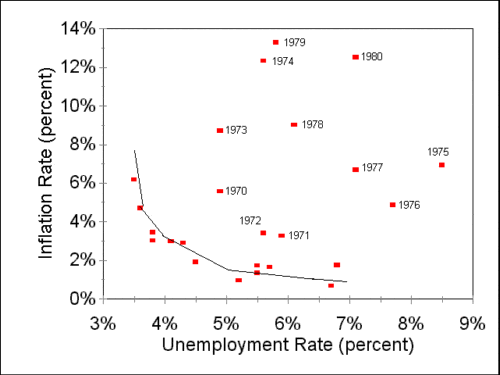
The second factor which influences this inverse relationship between money wage rate and unemployment is the nature of business activity. This is because, “when the demand for labour is high and there are very few unemployed we should expect employers to bid wage rates up quite rapidly.” This is because “workers are reluctant to offer their services at less than the prevailing rates when the demand for labour is low and unemployment is high so that wage rates fall very slowly.” On the other hand, when unemployment is low, the rate of increase in money wage rates is high. Basing his analysis on data for the United Kingdom, Phillips derived the empirical relationship that when unemployment is high, the rate of increase in money wage rates is low. Phillips who first identified it, it expresses an inverse relationship between the rate of unemployment and the rate of increase in money wages. The Phillips curve examines the relationship between the rate of unemployment and the rate of money wage changes. Both may become even more important in the coming years, because of technological improvements in the areas of artificial intelligence and robotics.ADVERTISEMENTS: The Phillips Curve: The Relation between Unemployment and Inflation: This would capture changes the labor market is experiencing because of the increasing importance of self-employment and online shopping. The author concluded that policymakers should consider using models that include more variables to explain inflation in the current economy, rather than simply relying on the benchmark, non-gig economic model. For the third quarter of 2018, his hybrid model had the natural rate of unemployment at around 4.09 percent, compared with the baseline of 5.87 percent. The author confirmed this by comparing a baseline model of the natural rate of unemployment with a hybrid model that accounted for both online sales and self-employment. This decreases the natural rate of unemployment and wages, further complicating how a central bank’s policies may affect the economy. As more and more of the workforce joins the gig-economy, it reduces the bargaining power of labor. To capture this variable, the author used IRS reports showing the share of individuals who paid the self-employment tax.

The author goes on to examine how the rise of self-employment created shifts in the workforce contributing to the flattening of the Phillips curve. This is can be attributed to brick-and-mortar retailers facing increased competition from online retailers which kept prices from rising too quickly. As the curve flattens, unemployment rate changes are slower to react to inflation changes.

Models predicted that the rise of online shopping has flattened the Phillips curve.

Census Bureau and individual income tax returns. Data for these variables come from the U.S. To test the effects of self-employment and online shopping, the author added self-employment and online sales to the Phillips curve’s model to examine how each has impacted the curve, both independently and together. Duca studies how self-employment (or gig employment) and online shopping may have affected inflation and unemployment rates in the current economy. In “ Inflation and the gig economy: have the rise of online retailing and self-employment disrupted the Phillips curve?” (Federal Bank of Dallas, Working Paper 1814, November 2018), author John V. As an economy recovers after a recession, the unemployment rate tends to fall (signaling a stronger economy) and the inflation rate tends to rise (because of rising wages). The Phillips curve explains the inverse relationship between inflation and unemployment. One tool economists use to predict inflation during recessions is the Phillips curve.

Economists have been studying why inflation did not fall further during the Great Recession, and why it has not risen more quickly during the recovery, as was true of past recessions.


 0 kommentar(er)
0 kommentar(er)
